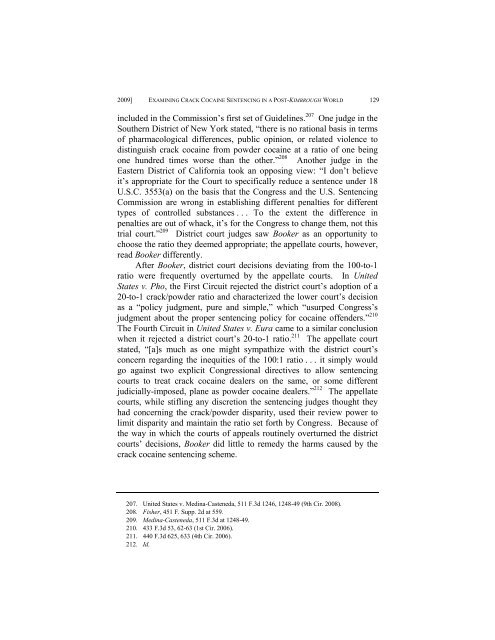Examining Crack Cocaine Sentencing in a Post- Kimbrough World
Examining Crack Cocaine Sentencing in a Post- Kimbrough World
Examining Crack Cocaine Sentencing in a Post- Kimbrough World
Create successful ePaper yourself
Turn your PDF publications into a flip-book with our unique Google optimized e-Paper software.
08-CASSIDY.DOC<br />
1/29/2009 3:29:23 PM<br />
2009] EXAMINING CRACK COCAINE SENTENCING IN A POST-KIMBROUGH WORLD 129<br />
<strong>in</strong>cluded <strong>in</strong> the Commission’s first set of Guidel<strong>in</strong>es. 207 One judge <strong>in</strong> the<br />
Southern District of New York stated, “there is no rational basis <strong>in</strong> terms<br />
of pharmacological differences, public op<strong>in</strong>ion, or related violence to<br />
dist<strong>in</strong>guish crack coca<strong>in</strong>e from powder coca<strong>in</strong>e at a ratio of one be<strong>in</strong>g<br />
one hundred times worse than the other.” 208 Another judge <strong>in</strong> the<br />
Eastern District of California took an oppos<strong>in</strong>g view: “I don’t believe<br />
it’s appropriate for the Court to specifically reduce a sentence under 18<br />
U.S.C. 3553(a) on the basis that the Congress and the U.S. <strong>Sentenc<strong>in</strong>g</strong><br />
Commission are wrong <strong>in</strong> establish<strong>in</strong>g different penalties for different<br />
types of controlled substances . . . To the extent the difference <strong>in</strong><br />
penalties are out of whack, it’s for the Congress to change them, not this<br />
trial court.” 209 District court judges saw Booker as an opportunity to<br />
choose the ratio they deemed appropriate; the appellate courts, however,<br />
read Booker differently.<br />
After Booker, district court decisions deviat<strong>in</strong>g from the 100-to-1<br />
ratio were frequently overturned by the appellate courts. In United<br />
States v. Pho, the First Circuit rejected the district court’s adoption of a<br />
20-to-1 crack/powder ratio and characterized the lower court’s decision<br />
as a “policy judgment, pure and simple,” which “usurped Congress’s<br />
judgment about the proper sentenc<strong>in</strong>g policy for coca<strong>in</strong>e offenders.” 210<br />
The Fourth Circuit <strong>in</strong> United States v. Eura came to a similar conclusion<br />
when it rejected a district court’s 20-to-1 ratio. 211 The appellate court<br />
stated, “[a]s much as one might sympathize with the district court’s<br />
concern regard<strong>in</strong>g the <strong>in</strong>equities of the 100:1 ratio . . . it simply would<br />
go aga<strong>in</strong>st two explicit Congressional directives to allow sentenc<strong>in</strong>g<br />
courts to treat crack coca<strong>in</strong>e dealers on the same, or some different<br />
judicially-imposed, plane as powder coca<strong>in</strong>e dealers.” 212 The appellate<br />
courts, while stifl<strong>in</strong>g any discretion the sentenc<strong>in</strong>g judges thought they<br />
had concern<strong>in</strong>g the crack/powder disparity, used their review power to<br />
limit disparity and ma<strong>in</strong>ta<strong>in</strong> the ratio set forth by Congress. Because of<br />
the way <strong>in</strong> which the courts of appeals rout<strong>in</strong>ely overturned the district<br />
courts’ decisions, Booker did little to remedy the harms caused by the<br />
crack coca<strong>in</strong>e sentenc<strong>in</strong>g scheme.<br />
207. United States v. Med<strong>in</strong>a-Casteneda, 511 F.3d 1246, 1248-49 (9th Cir. 2008).<br />
208. Fisher, 451 F. Supp. 2d at 559.<br />
209. Med<strong>in</strong>a-Casteneda, 511 F.3d at 1248-49.<br />
210. 433 F.3d 53, 62-63 (1st Cir. 2006).<br />
211. 440 F.3d 625, 633 (4th Cir. 2006).<br />
212. Id.
















